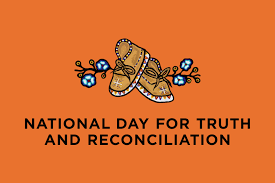September 30 marks the National Day for Truth and Reconciliation, a time for Canadians to pause, reflect, and acknowledge a difficult truth: for more than a century, residential schools separated Indigenous children from their families, stripped them of their languages and cultures, and left a legacy of pain that continues today.
The day is also known as Orange Shirt Day, inspired by the story of Phyllis Webstad, who had her new orange shirt taken away on her first day at a residential school. The shirt has since become a symbol of the stripping away of identity – and a reminder that Every Child Matters.
At its heart, reconciliation is about repairing relationships between Indigenous and non-Indigenous peoples. It is about truth-telling, listening, and learning, while also taking action to ensure past wrongs are never repeated.
The Truth and Reconciliation Commission of Canada, which gathered more than 6,000 testimonies from survivors, reminded Canadians that reconciliation is not a single act or apology – it is a journey. It means addressing systemic inequalities in health, education, and justice, and it means every Canadian has a role to play.
For communities in Eastern Nova Scotia and Western Cape Breton Island, reconciliation is not an abstract idea – it is lived history. This land is Mi’kma’ki, the traditional and unceded territory of the Mi’kmaq people, whose presence stretches back thousands of years.
Local Mi’kmaq communities such as Pictou Landing, Paqtnkek, Potlotek, Wagmatcook, and We’koqma’q continue to feel the intergenerational effects of residential schools. Survivors and their families carry stories of loss, resilience, and strength that must be heard and honoured.
At the same time, these communities are leading the way forward. Through powwows that bring people together, initiatives to revitalize the Mi’kmaw language, and environmental stewardship rooted in traditional knowledge, they show that reconciliation is not just about acknowledging the past but also about building a shared future.
Reconciliation Day honours the children who never returned home from residential schools, the survivors who endured unimaginable hardships, and the families and communities forever changed by those experiences.
But it is also a day to recognize resilience. The Mi’kmaq people of this region – and across Canada – continue to shape our culture, our land, and our future. Their contributions are woven into the fabric of everyday life, from education and governance to music, art, and sport.
Across Pictou, Antigonish, Guysborough, Inverness, and Richmond Counties, efforts are underway to strengthen partnerships between Indigenous and non-Indigenous communities. Schools are incorporating Mi’kmaq history into classrooms, local municipalities are engaging in dialogue with Mi’kmaq leaders, and community members are invited to participate in events led by Indigenous voices.
These steps, while meaningful, are only part of the journey. Reconciliation requires ongoing commitment, not only from governments and institutions but from individuals – neighbours, colleagues, classmates, and friends.
On this National Day for Truth and Reconciliation, Canadians are encouraged to wear orange, attend ceremonies, and most importantly, listen. For Eastern Nova Scotia and Western Cape Breton, this means showing up for community events in Pictou Landing, Paqtnkek, Potlotek, Wagmatcook, and We’koqma’q, and taking the time to learn directly from Mi’kmaq voices.
Reconciliation is not about erasing the past. It is about facing it honestly, learning from it, and committing to a future rooted in respect and understanding.
This September 30, as orange shirts fill classrooms, community halls, and streets, let us remember the children, honour the survivors, and stand with the Mi’kmaq people whose strength continues to guide us forward.
Healing begins with truth – and reconciliation begins with all of us.


